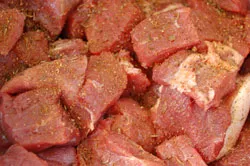
Protect yourself and others from illness by preparing safe meals.
Hygiene
- Always wash your hands before and after handling food (especially raw food) and utensils,and after touching your mouth, smoking, coughing or eating in the kitchen. Use soap and scrub hands thoroughly, especially under fingernails, and rinse with warm water.
- Do not prepare food if you're sick
- If your hands have cuts our wounds, use disposable gloves for extra protection
Food Temperatures
Storing foods
- Perishable foods can be stored safely for up to a week (or to the labeled expiration date) in your refrigerator at or below 41°F.
- Hot foods may be kept safely at 140°F or above.
- Temperatures between 41°F to 140°F are good for growing germs, which is known as the Danger Zone. Perishable foods in the Danger Zone more than four hours may produce enough germs to make people ill and should be thrown away.
Check temperatures
Use a five-inch long metal stem thermometer to check food temperatures. You can purchase a thermometer with a temperature range from 0°F to 220°F at the local supermarket or department store. Always wash off the thermometer's metal stem before using it.
Cooling food
Leftovers or foods prepared a day before serving require proper cooling to limit the growth of germs. The cooling process must drop food below 41°F within four hours. After the temperature drops below 140°F, place food in an uncovered shallow pan for rapid cooling and store in refrigerator immediately. When cooling warm foods, do not leave them out at room temperature.
For large containers of hot food, divide it into smaller containers and store each separately in the refrigerator to prevent food near the edge of the container from cooling faster than food in the middle. Do not cover foods until the product has cooled to 41°F. Another way to cool large containers of warm food is by using an ice water bath. Set your container of food in a clean sink or tub of cold water with ice cubes.
Cooking temperatures
Cooking food to the proper temperature will kill the harmful germs in raw foods that cause foodborne illness. The guide below lists internal temperatures that should be met or exceeded throughout the food. Test the food with your metal stem thermometer and for large containers or roasts, check temperatures in several spots. If in doubt, cook all food thoroughly to 165°F.
What's Cookin'
Poultry, stuffed meats, stuffing with meat - 165°F
Ground beef, ground fish - 155°F
Pork - 145°F
Eggs, fish, and other food - 145°F
Leftovers and microwave able food - 165°F (in all parts)
Don't Cross Contaminate
Prevent contamination and illness by storing foods properly.
- Keep dry foods in metal or glass containers with tight-fitting lids.
- Store cleaning supplies and pesticides away from food items.
- Do not store foods under water or sewage pipes that may leak or drip.
- Keep foods off the floor to avoid contamination from mop water, sewage back-ups, or spills.
- Store raw meats in your fridge away from and below other foods. Keep raw meat juices from dripping onto other foods.
Cutting boards should be scrubbed with detergent and rinsed with hot water after each use, and especially after preparing raw meats. Sanitize cutting boards after washing with a mild bleach water solution using a teaspoon of bleach per gallon of water.
Food Safety Hints
Simplify recipes. The more heating and cooling steps in a recipe, the greater chance germs have to grow. Eliminate unnecessary steps and combine processes if possible.
Keep prep time short. Try to prepare meals less than a day in advance because risky foods need to be cooled for overnight storage and then reheated the next day. Either procedure, if not correctly done, will allow germs to grow.
Big meals need big kitchens. If you plan to prepare a large quantity of food, consider using a licensed commercial kitchen. These facilities normally have larger preparation and storage areas.
Food Recalls
For breaking food recalls and alerts: www.foodsafety.gov
